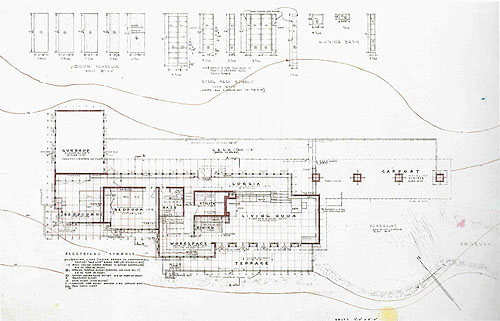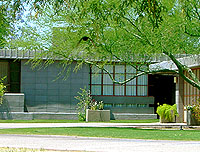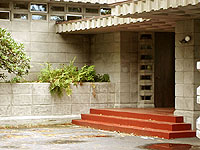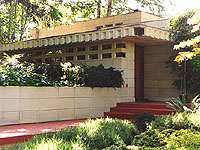|
|
-
Wright Studies
J. L. Smith Residence,
Kane County, Illinois (1955) (Project 5522) |
|
|
|
THREE SMITH PROJECTS
SMITH SCHEME 1 (1954)
SMITH SCHEME
2 (1955) SMITH FINAL PLANS (1956) |
|
USONIAN AUTOMATIC HOMES (BUILT)
USONIAN AUTOMATIC
TRAVELING EXHIBIT
|
|
|
|
Three
Smith Projects |
|
|
|
|
|
After acquiring two original blueprints for the J. L.
Smith Residence, our research took us to the Avery
Architectural & Fine Arts Library at Columbia University,
New York City, where the Frank Lloyd Wright archives are
held. They discovered two additional projects related to J.
L. Smith, so we proceeded to obtain all correspondence
related to Smith. The first was the Cooperative Homestead
Project in Detroit, Michigan, FLLW 4201. Wright designed a
community of approximately 20 berm type homes for the
project. There are a total of 42 letters between Frank Lloyd
Wright and J. L. Smith, the secretary of the Cooperative
Homestead, Inc. which began on December 4th, 1941 and
continued until July 31st, 1945. Smith's mailing address was
first Hazel Park then changed to Royal Oak, Michigan during
the period of correspondence. The war,
as well as other problems
|
|
that arose brought an end to the
project. The design later became the concept for the Thomas
Keys Home (1950 - S.321.)
The second J. L. Smith occurrence was in 1948. Mr. And Mrs.
James L. Smith, Marshal, Missouri, requested Wright to
design a home for them. The first letter was dated August
24, 1948. The fifth and final letter was from Frank Lloyd
Wright on November 6, 1948. "Dear Mrs. Smith: We do not
build on less than acreage - sorry."
The third is this project. After having the opportunity to
review all of the correspondence for all three projects,
there were no references to earlier projects, which leads to
the conclusion that Smith was a common name, and it was just
a coincidence that all three had the initials "J. L." in
there name.
March
2017. |
|
|
|
|
|
|
J. L.
Smith Residence Scheme 1 |
|
|
|
Wright/Smith Correspondence: In the
Avery Library there twelve letter and notes between Frank
Lloyd Wright, Gene Masselink and J. L. Smith. October 30,
1953: "Dear Mr. Frank Lloyd Wright: Could we make an
appointment to see you about designing a home for us? We
came up to Spring Green early this year to talk to you, but
Mr. Hill informed us that you were away lecturing at that
time... The typo map is enclosed..." J. L. Smith, Dundee,
Illinois. November 7, 1953: "Dear Mr. Smith: Mr. Wright has
been in New York almost continuously since October 7th in
connection with the exhibition of his work there on Fifth
Avenue at the site of the Guggenheim gallery... If you could
send Mr. Wright a complete list of your requirements, and
give his an idea of your financial limitations..." Eugene
Masselink.
A year
later, January 3, 1955, a registered package is returned to
Wright in Scottsdale. It does not indicate what was
returned, but a clue might be in the file holding the plans
for the Smith project. A) Bruce Brooks Pfeiffer published a
single
|
|
preliminary plan for a "One Room House" in
Monograph
1951-1959, p.143. Although undated, Pfeiffer dates the
plan 1954. The "One Room House, Usonian Automatic System,
980 square feet," included a Living Room, Workspace, two
Bedrooms and one Bath. Included in the Smith file are three
additional undated preliminary plans, all "Usonian
Automatic" and all two-bedrooms. B) A second variation is
"870 Square Feet." C) A third variation has a couple hand
written notes, "$5000 Cottage," "1028 sq. ft." and "1180."
Because these four preliminary drawings are only titled
"Usonian Automatic" it might be assumed that these early
plans may have been left in this file by accident. But the
fourth gives a clue that they belong. D) The fourth
variation has the addition of a detached "Gun Shop" which
becomes a common thread and important element in all of the
Smith plans. Pfeiffer indicates that these first preliminary
plans were to minimal for the Smiths, and a larger plan was
then proposed. |
| |
|
|
|
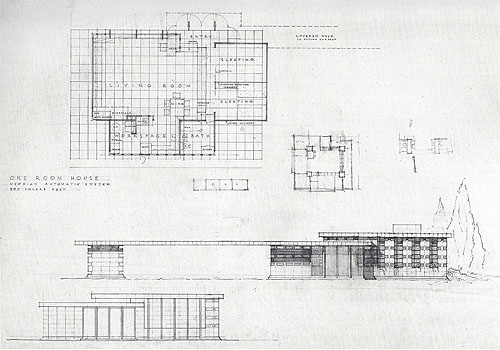 |
| A-1) Preliminary Plan. "One Room
House, Usonian Automatic System, 980 square feet," included
a Living Room, Workspace, two Bedrooms and one Bath.
Published in
Monograph
1951-1959, p.143. Courtesy of the Frank Lloyd Wright
Foundation. |
|
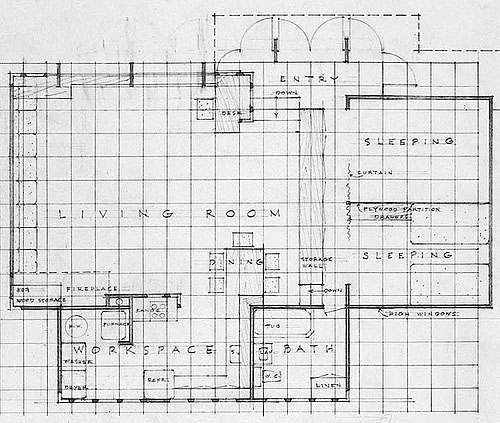 |
| A-2)
Preliminary Plan Detail. Doors in the Entry open outward,
eliminating the corners. From the Entry and Bedrooms, stairs
lead down to the Living Room level. There is only a storage
wall separating the Living Room from the Bedrooms. A curtain
is indicated for Bedroom privacy. |
| |
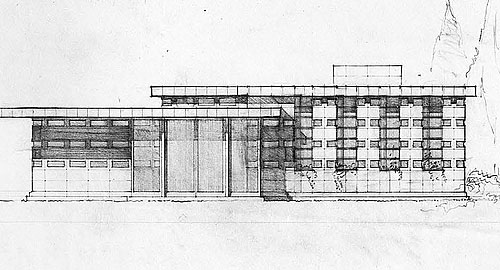 |
| A-3)
Preliminary Plan Detail. The floor to ceiling Entry doors
open outward, eliminating the corners. The upper perforated
blocks are glazed with glass. |
|
|
|
|
|
|
|
|
J. L.
Smith Residence Scheme 2 |
|
|
|
|
|
Wright/Smith Correspondence Continued:
The second set of plans, (Scheme 2), is dated January 20,
1955 and is for a much larger home, over 1,500 square feet
when you include the Gun Shop. This design placed the two
bedrooms at Northwest end of the house, the Workspace, Bath
and an additional Utility room in the center, and the Living
Room on the Southeast end. A Loggia/Gallery ties the rooms
together and runs along the Northeast side of the home. A
Carport is connected to the Living Room and continues
Southeast. The Gun Shop is separated by the Lanai and is
embedded into the hillside. There are seven sheets in the
file that are related to the Scheme. Four of which are
titled "House for Mr. & Mrs. J. L. Smith." 1) "Elevations."
2) "General Plan." 3) "Sheet 2, Plot Plan." 4) "Sheet 3,
Elevations." 5) "Southwest Elevation." A variation on the
Carport. 6) "Southwest Elevation." A variation on the Living
Room. 7) "Southwest Elevation." A variation on the Living
Room.
On January
26th, 1955 the Smiths were billed $1,250. "On account for
Preliminary Sketches,,, 5% of $25,000, proposed cost of
house..."
The Smiths
responded one week later with a two page letter. "February
4, 1955. Dear Mr. Wright. A check is inclosed for our
preliminary sketches and the more we study them the more
|
|
enthusiastic we become. We have been reading your new book
Natural House and would like to build as much of our home as
we can... Will a work shop dug into the hill be warm, dry
and comfortable to use. I store French walnut gun stock
blanks, tools, parts in the shop; all of which should not
get damp. Wouldn't it be better to have the shop parallel to
the home instead of into the hill to reduce digging into the
hill... Can we work out storage for a 16 ft Old Town Canoe
near the carport. Can we make a high step in the retaining
wall behind carport to store the canoe. Sincerely J. L.
Smith."
Masselink
responds a week later, "Dear Mr. Smith, Mr. Wright
acknowledges your check with thanks. As soon as he is back
from Wisconsin and New York he will give your letter his
careful attention... February 10th, 1955. P.S. We would need
the preliminary sketches before work could begin upon the
working drawings."
"May 21, 1955... On March 11, we returned our sketches to
you by registered mail, since we have not heard from you we
would like to know if they were received... If Mr. Wright
will be in Wisconsin the beginning of June or so, we would
like to make a date to come up to see him, Yours truly, J.
L. Smith." |
| |
|
|
|
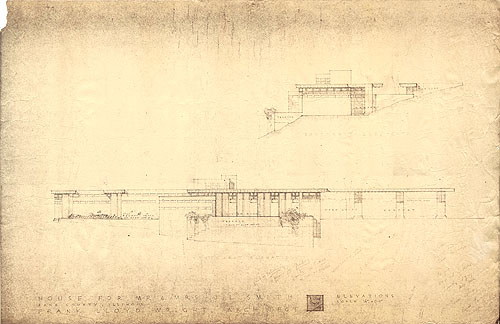 |
| 1A) J. L. Smith Elevations Blueprint
1955. "House For Mr. & Mrs. J. L. Smith. Kane County,
Illinois. Frank Lloyd Wright Architect. Frank Lloyd Wright,
Jan 20 / 55. Elevations. Scale 1/4" = 1' - 0"." Upper:
"Southeast Elevation." The Terrace is on the far left. The
ceiling in the Workspace is lowered for the first three
feet, then raises up to the height of the Living Room. The
Loggia is to the right of the Living Room, and lines up with
the Carport in the foreground. The Gun Shop is to the far
right, embedded into the hillside. Lower: "Southwest
Elevation." The two Bedrooms are on the left. Both have
corner doors that open outward. The Workspace is to the
right of the Bedrooms, the ceiling has been lowered. The
Living room has four sets of floor-to-ceiling doors that
open outward, set between two foot wide columns. The carport
is to the far right. There are handwritten notes in pencil
toward the bottom right. "Print of Preliminary Plans for
Grading Prints on Forms as Soon as Possible. Workshop - Dry
- Gun Shop. Fireplace Storage. No Cabinets over Sink.
Carport. View out of Kitchen... Laundry Equip, deep sink.
Canoe Storage. Lanai Larger. Laundry Larger." The notes on
both sheets, and the fact that Gun Shop was relocated, would
indicate that the Smiths were very serious about completing
this project. We were not able to uncover why the project
was never built. Original Blueprint 24" x 36".
(S#1092.99.0117-1) |
| |
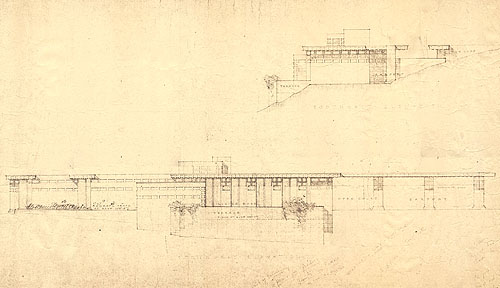 |
| 1B) Detail of the J. L. Smith
Elevations Blueprint 1955. |
| |
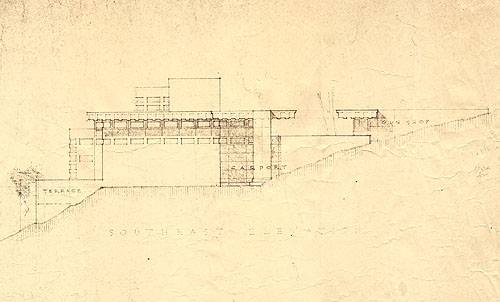 |
| 1C) J. L. Smith Elevations Blueprint
1955. Detail of the Southeast Elevation. The Terrace is on
the far left. The ceiling in the Workspace is lowered for
the first three feet, then raises up to the height of the
Living Room. The Loggia is to the right of the Living Room,
and lines up with the Carport in the foreground. The Gun
Shop is to the far right, embedded into the hillside. |
| |
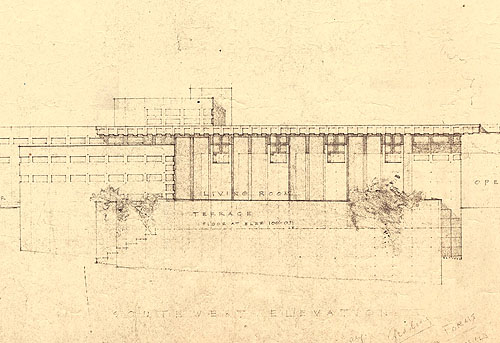 |
| 1D) J. L. Smith Elevations Blueprint
1955. Detail of the Southwest Elevation. The two Bedrooms
are on the far left (out of frame). The Workspace is to the
left, the ceiling has been lowered. The Living room has four
sets of floor-to-ceiling doors that open outward, set
between two foot wide columns. The carport is to the far
right (out of frame). |
| |
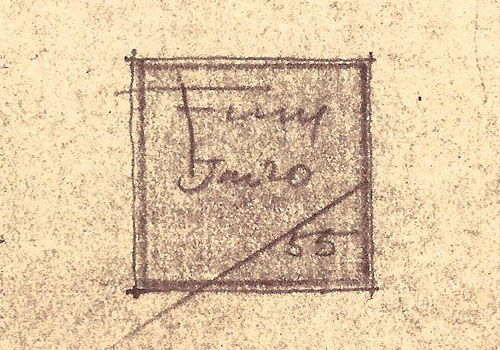 |
| 1E) Detail of dated blueprint, "Jan
20 / 55." |
| |
 |
| 2A) J. L. Smith
General Plan Blueprint 1955. "House For Mr. & Mrs. J. L.
Smith. Kane County, Illinois. FLW Architect. FLW, Jan 20 /
55. General Plan. Scale 1/4" = 1' - 0"." The home is built
into a hillside and faces Southwest. The elevation at the
South corner of the Terrace is 92 feet. The elevation of the
North corner of the Gun shop is 110 feet, a change of 18
feet. As in other Usonian Automatic homes, these blocks are
1' x 2' in size, and the floor plan is designed in 2' x 2'
modules. The home is built on two levels. As you drive up to
the graveled forecourt, and park in the Carport, a covered
walk leads to the Entrance which is along the back of the
house. The Lanai is on the right, the Gun Shop is embedded
into the hillside. Double doors lead to the Entryway which
is on the upper level. The Gallery on the right leads to two
Bedrooms, the Bath, and a thin passageway leading down five
stairs to the Workspace on the lower level. As you walk down
the Loggia to the left, there are built-in bookshelves on
the left, low built-in cabinets on the right. The wall on
the right side is open, creating the Loggia. At the end,
five stairs lead down to the Living Room. The bookshelves
that cover the right side of the Loggia wrap around the end,
then continue into the Living room and rap around two
additional walls. The Southwest side of the Living room has
four sets of tall thin floor-to-ceiling doors that open
outward to the Terrace. Original Blueprint 24" x 36".
(S#1092.99.0117-2) |
|
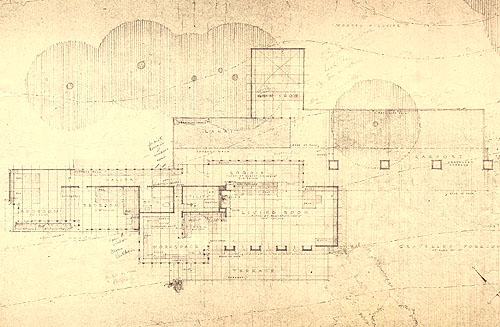 |
| 2B) Detail of the J. L. Smith
General Plan Blueprint 1955. Each door is 2' x 10' creating
2' x 4' sets, between 2' wide columns. The height of the
ceiling above the upper level is 7' 6" and is 10' above the
lower level. A built-in planter borders the stairs that lead
down from the Terrace. From the Entry, as you turn right,
the Gallery leads to the Bath and two Bedrooms. Built-in
cabinets are on the right side. Both Bedrooms have
floor-to-ceiling corner sets of doors. When closed they
create the corner of the room. When they are opened outward,
the corner is open. The smaller Bedroom set has one door
that is 2' wide, the other is 1' wide. The larger Bedroom
set are both 2' wide. The roof extends outward above the
doors sheltering the openings. There is a large built-in
planter box just outside the larger bedroom. There are
handwritten notes in pencil. Shop: "Gun" is crossed out and
replaced with "Work." "To wk in winter. Shop must be
comfortable. Heat Ste. No Sun in afternoon. Stairway to top
of hill. Gallery: For air to come in > Windows open. (Open
windows in Blocks.) Large Bedroom: Open windows. Small
Bedroom: Open windows. Cross ventilation. Workspace: Built
in oven + Range." |
| |
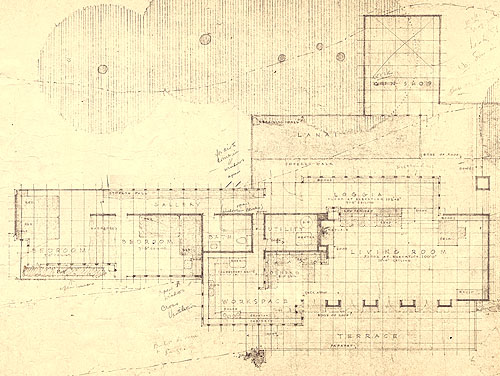 |
| 2C) J. L. Smith
General Plan Detail. The home is built on two levels. As you park in the Carport, a covered
walk leads to the Entrance which is along the back of the
house. The Lanai is on the right, the Gun Shop is embedded
into the hillside. Double doors lead to the Entryway which
is on the upper level. The Gallery on the right leads to two
Bedrooms, the Bath, and a thin passageway leading down five
stairs to the Workspace on the lower level. As you walk down
the Loggia to the left, there are built-in bookshelves on
the left, low built-in cabinets on the right. The wall on
the right side is open, creating the Loggia. At the end,
five stairs lead down to the Living Room. The bookshelves
that cover the right side of the Loggia wrap around the end,
then continue into the Living room and rap around two
additional walls. The Southwest side of the Living room has
four sets of tall thin floor-to-ceiling doors that open
outward to the Terrace. |
| |
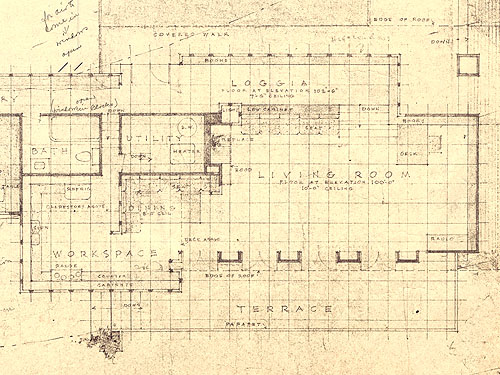 |
| 2D) Detail of the J. L. Smith living
area. Each door is 2' x 10' creating
2' x 4' sets, between 2' wide columns. The height of the
ceiling above the upper level is 7' 6" and is 10' above the
lower level. A built-in planter borders the stairs that lead
down from the Terrace. From the Entry, as you turn right,
the Gallery leads to the Bath and two Bedrooms. Built-in
cabinets are on the right side. Both Bedrooms have
floor-to-ceiling corner sets of doors. When closed they
create the corner of the room. When they are opened outward,
the corner is open. There is a large built-in
planter box just outside the larger bedroom. |
| |
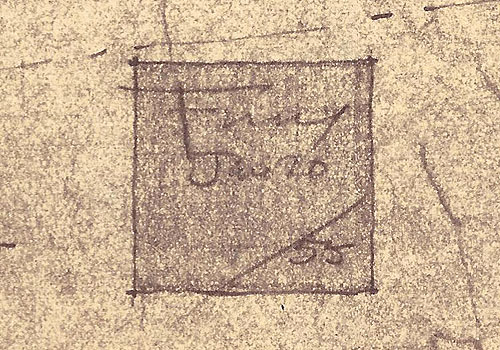 |
| 2E) Detail of dated blueprint, "Jan
20 / 55." |
| |
|
|
|
|
|
|
J. L.
Smith Residence Final Plans |
|
|
|
|
|
Wright/Smith Correspondence Continued:
On January 31, 1956, Smith received a registered package
from Frank Lloyd Wright.
The third, final and complete set of plans, Scheme 2B,
appear to be dated February 15, 1956. There are eight
sheets, each is titled, "House For Mr. & Mrs. J. L. Smith.
Kane County, Illinois. Frank Lloyd Wright Architect. Frank
Lloyd Wright." The only major change was to move the Gun
Shop "parallel to the home instead of into the hill" like
Smith had suggested. The sheets include: Sheet 1, Plot Plan;
Sheet 2, General Plan; Sheet 3, Elevations; Sheet 4,
Sections; Sheet 5, Electrical (2); Sheet 6, Details of
Workspace; Sheet 7, Roof Plan.
On March 24th, Masselink sent Smith a letter, "Your working
drawings and specifications were mailed directly from the
Arizona Blue Print Company - We hope you received them
safely."
On April
4th, Smith responds with a hand written note, "Thank you for
the beautiful plans. We are having a contractor in Elgin,
Mr. Hartman look at them. He is enthusiastic about working
with us. I would appreciate the blue-prints of the block
forms - the detailed drawings of metal forms for all type
blocks. Yours truly, J. L. Smith."
Two weeks later Masselink responds. "Dear Mr. Smith: This
will acknowledge your letter and your check of one thousand
dollars. Thank you. We are glad to know you have a
contractor who is enthusiastic about working with you. That
should be a great help. We are leaving for Wisconsin shortly
and will send you the prints of the block forms then - if
not before. April 16th, 1956."
"Dear Mr. Smith: Your revised heating plan was mailed to you
yesterday. We find that we have no record of whatever else
you requested when you visited Taliesin some weeks ago.
Could you let us know so that we may send you the necessary
drawings,
|
|
etc? Sincerely, Eugene Masselink. Secretary to Frank
Lloyd Wright. Sept 26th, 1956."
End of correspondence. Silence... There is no record as to
why Smith did not build the home. He owned the lot. Wright
was very accommodating. Smith seemed pleased. He had a
contractor that was enthusiastic. Everything was falling
into place. At this time, there is just not enough
information related to J. L. Smith that would answer the
question. This project became one of the 500 that would
never come to fruition.
According to
Pfeiffer, "The J. L. Smith house is another Usonian
Automatic with an elongated plan stretching from the carport
at one end to the master bedroom at the other. A covered
walk proceeds from the carport at one end to the master
bedroom at the other. A covered walk proceeds from the
carport to a gun shop set at right angles to the last
bedroom. Partway along the covered walk is the entrance to
the house, gaining a loggia on the left as one enters with
five steps down into the living room. Near the fireplace are
the dining alcove and workspace. By staggering the bedrooms
in the plan, each room has the advantage of a corner
open-swinging window. As is apparent from the study of the
elevations, the combination of solid blocks and perforated
ones is unlike any of Wright’s other Usonian Automatic
designs..
Frank
Lloyd Wright, Complete Works 1943-1959,
Pfeiffer, 2009.
Kane
County is west of Chicago, including to towns of Aurora,
Elgin, Geneva and St. Charles. Also in Kane County is the
Robert and Elizabeth Muirhead Farmhouse Residence 1950
(S.334) in Plato Center. The P.D. Hoyt Residence 1906
(S.120), in Geneva. The A.W. Gridley Residence (1906 (S.121)
in Batavia. The Fabyan Remodeling (Fabyan Villa) 1907,
(S.129). The Fox River Country Club Addition 1907 (S.130) |
|
|
|
|
|
|
|
|
|
|
|
Usonian Automatic Homes (Built) |
|
|
|
Usonian Automatic Homes, 1949, Frank Lloyd Wright
Foundation Project Number 5612. As early as 1923, Wright
designed four textile block homes in California. 1) Millard
(La Miniatura) (1923 - S.214), 2) Storer Residence (1923 -
S.215), 3) Freeman (1923 - S.216 and 4) Ennis (1923 -
S.217). Wright designed many homes utilizing the concrete
block including many of the his Usonian homes. The first
home generally recognized as a Usonian home was the Jacobs
1, 1936. It was not until 1949 that Wright began solidifying
his concepts for the Usonian Automatic Home and refined the
design over the next two year. The first Usonian Automatic
Homes was the Benjamin Adelman House, FLLW 5101 (1951 -
S.344). Other completed homes include the Arthur Pieper
Desert Cottage, FLLW 5218 (1952 - S.349), Gerald Tonkens
House, FLLW 5510 (1954 - S.386), Dr. Toufic H. Kalil
House, FLLW 5506
(1955 - S.387), Dorothy Turkel House, FLLW 5513
(1955 - S.388), William B. Tracy House, FLLW 5512
(1955 - S.389) and T. A. Pappas House, FLLW 5516
(1955 - S.392).
The
J. L. Smith Residence was one of the homes designed as a
Usonian Automatic. Others homes designed but never executed
included the Blumberg and Sussman Residences, both 1955.
From January 1988 through March 1991, "Frank Lloyd Wright:
In The Realm of Ideas" a traveling exhibition included a
full-scale Usonian Automatic model. The design that was
chosen for the full-scale model was the Sussman Residence
(project).
Other Usonian Automatic Homes
(Projects):
1949 - The Usonian Automatic
Project, FLLW 5612, p.216-217*.
|
|
1953 - Pieper-Montooth Building, Project, "Horizon
Builders," FLLW 5311, p.337*.
1954 - Louis B. Fredrick
House, Project, Scheme 1, FLLW 5426, p.363*.
1954 -
Arthur J. Levin House, Project, FLLW 5633, p.373*.
1955 -
Mel Blumberg House, Project,
FLLW 5502, p.388*.
1955 - Clinic for Dr. Kundert and Dr.
Fofo, Project, Scheme 1, FLLW 5640, p.408*.
1955 - Don
Lovness Original House, Project, FLLW 5507, p.412*. Was
constructed of stone, S.391.
1955 - Oscar Miller House,
Project, FLLW 5602, p.413*.
1955 - J. L. Smith
Project, FLLW 5522, p.424*
1955 - Robert Sunday
House, Original Project, FLLW 5522, p.425*. Was constructed
of brick, S.393.
1955 - Gerald Sussman House, Project,
FLLW 5524, p.426*.
1956 - Andrew B Cook House, Project,
Scheme 2, FLLW 5525, p.444*.
1956 - David Hunt House,
Project, FLLW 5601, p.457*.
1956 - Leonard Janowski
House, Project, Scheme 2. FLLW 5538, p.458*.
1957 -
Usonian Housing, Project for Walter Bimson. FLLW 5740,
p.495*.
1957 (S.421) - Dr. Robert G. Walton House,
originally called for Usonian Automatic construction,
abandon for standard concrete block construction. FLLW 5623,
p.519-520*.
*Frank
Lloyd Wright, Complete Works 1943-1959 |
| |
|
|
|
|
|
|
Text copyright
Douglas M. Steiner, Copyright 2017. |
|
|
|
|
|
J. L.
Smith Residence |
|
|
|
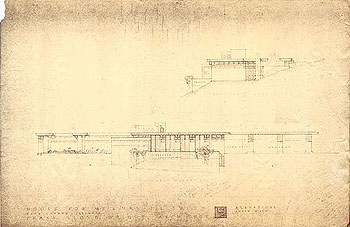 |
Date:
1955
Title:
J. L. Smith Elevations Blueprint 1955 (Project)
Description:
"House For Mr. & Mrs. J. L. Smith. Kane County,
Illinois. Frank
Lloyd Wright Architect.
Frank Lloyd Wright,
Jan 20 / 55. Elevations. Scale 1/4" = 1' - 0"." Upper: "Southeast
Elevation." The Terrace is on the far left. The ceiling in the
Workspace is lowered for the first three feet, then raises up to the
height of the Living Room. The Loggia is to the right of the Living
Room, and lines up with the Carport in the foreground. The Gun Shop
is to the far right, embedded into the hillside. Lower: "Southwest
Elevation." The two Bedrooms are on the left. Both have corner doors
that open outward. The Workspace is to the right of the Bedrooms,
the ceiling has been lowered. The Living room has four sets of
floor-to-ceiling doors that open outward, set between two foot wide
columns. The carport is to the far right. There are handwritten
notes in pencil toward the bottom right. "Print of Preliminary Plans
for Grading Prints on Forms as Soon as Possible. Workshop - Dry -
Gun Shop. Fireplace Storage. No Cabinets over Sink. Carport. View
out of Kitchen... Laundry Equip, deep sink. Canoe Storage. Lanai
Larger. Laundry Larger." The notes on both sheets, and the fact that
Gun Shop was relocated, would indicate that the Smiths were very
serious about completing this project. We were not able to uncover
why the project was never built.
See Wright Study on J. L. Smith Residence
Project.
Size:
Original Blueprint 24" x 36".
S#:
1092.99.0117-1 |
|
|
|
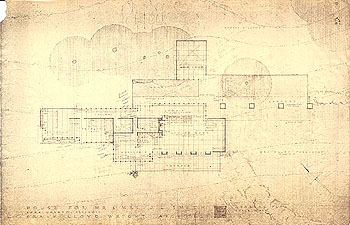 |
Date:
1955
Title:
J. L. Smith General Plan Blueprint 1955
(Project)
Description:
"House For Mr. & Mrs. J. L. Smith. Kane County, Illinois.
Frank Lloyd Wright
Architect.
Frank Lloyd Wright,
Jan 20 / 55. General Plan. Scale 1/4" = 1' - 0"." The home is built
into a hillside and faces Southwest. The elevation at the South
corner of the Terrace is 92 feet. The elevation of the North corner
of the Gun shop is 110 feet, a change of 18 feet. As in other
Usonian Automatic homes, these blocks are 1' x 2' in size, and the
floor plan is designed in 2' x 2' modules. The home is built on two
levels. As you drive up to the graveled forecourt, and park in the
Carport, a covered walk leads to the Entrance which is along the
back of the house. The Lanai is on the right, the Gun Shop is
embedded into the hillside. Double doors lead to the Entryway which
is on the upper level. The Gallery on the right leads to two
Bedrooms, the Bath, and a thin passageway leading down five stairs
to the Workspace on the lower level. As you walk down the Loggia to
the left, there are built-in bookshelves on the left, low built-in
cabinets on the right. The wall on the right side is open, creating
the Loggia. At the end, five stairs lead down to the Living Room.
The bookshelves that cover the right side of the Loggia wrap around
the end, then continue into the Living room and rap around two
additional walls. The Southwest side of the Living room has four
sets of tall thin floor-to-ceiling doors that open outward to the
Terrace. Each door is 2' x 10' creating 2' x 4' sets, between 2'
wide columns. The height of the ceiling above the upper level is 7'
6" and is 10' above the lower level. A built-in planter borders the
stairs that lead down from the Terrace. From the Entry, as you turn
right, the Gallery leads to the Bath and two Bedrooms. Built-in
cabinets are on the right side. Both Bedrooms have floor-to-ceiling
corner sets of doors. When closed they create the corner of the
room. When they are opened outward, the corner is open. The smaller
Bedroom set has one door that is 2' wide, the other is 1' wide. The
larger Bedroom set are both 2' wide. The roof extends outward above
the doors sheltering the openings. There is a large built-in planter
box just outside the larger bedroom. There are handwritten notes in
pencil. Shop: "Gun" is crossed out and replaced with "Work." "To wk
in winter. Shop must be comfortable. Heat Ste. No Sun in afternoon.
Stairway to top of hill. Gallery: For air to come in > Windows open.
(Open windows in Blocks.) Large Bedroom: Open windows. Small
Bedroom: Open windows. Cross ventilation. Workspace: Built in oven +
Range." The Gun Shop was moved to the North corner of the home in
the floor plans published in "Frank
Lloyd Wright, Complete Works 1943-1959".
See Wright Study on J. L. Smith Residence
Project.
Size:
Original Blueprint
24" x 36".
S#:
1092.99.0117-2 |
|
|
|
 |
Date:
1955
Title:
J. L. Smith Elevations Blueprint 1955 (Project)
Description:
"House For Mr. & Mrs. J. L. Smith. Kane County, Illinois. Frank
Lloyd Wright Architect. Frank Lloyd Wright, Jan 20 / 55. Elevations.
Scale 1/4" = 1' - 0"." Upper: "Southeast Elevation." The Terrace is
on the far left. The ceiling in the Workspace is lowered for the
first three feet, then raises up to the height of the Living Room.
The Loggia is to the right of the Living Room, and lines up with the
Carport in the foreground. The Gun Shop is to the far right,
embedded into the hillside. Lower: "Southwest Elevation." The two
Bedrooms are on the left. Both have corner doors that open outward.
The Workspace is to the right of the Bedrooms, the ceiling has been
lowered. The Living room has four sets of floor-to-ceiling doors
that open outward, set between two foot wide columns. The carport is
to the far right. There are handwritten notes in pencil toward the
bottom right. "Print of Preliminary Plans for Grading Prints on
Forms as Soon as Possible. Workshop - Dry - Gun Shop. Fireplace
Storage. No Cabinets over Sink. Carport. View out of Kitchen...
Laundry Equip, deep sink. Canoe Storage. Lanai Larger. Laundry
Larger." The notes on both sheets, and the fact that Gun Shop was
relocated, would indicate that the Smiths were very serious about
completing this project. We were not able to uncover why the project
was never built.
See Wright Study on J. L. Smith Residence
Project.
Size:
10 x 8 Color Print.
S#:
1092.100.0317-1 |
|
|
|
 |
Date:
1955
Title:
J. L. Smith General Plan Blueprint 1955 (Project)
Description: "House For Mr. & Mrs. J. L. Smith.
Kane County, Illinois. Frank Lloyd Wright Architect. Frank Lloyd
Wright, Jan 20 / 55. General Plan. Scale 1/4" = 1' - 0"." The home
is built into a hillside and faces Southwest. The elevation at the
South corner of the Terrace is 92 feet. The elevation of the North
corner of the Gun shop is 110 feet, a change of 18 feet. As in other
Usonian Automatic homes, these blocks are 1' x 2' in size, and the
floor plan is designed in 2' x 2' modules. The home is built on two
levels. As you drive up to the graveled forecourt, and park in the
Carport, a covered walk leads to the Entrance which is along the
back of the house. The Lanai is on the right, the Gun Shop is
embedded into the hillside. Double doors lead to the Entryway which
is on the upper level. The Gallery on the right leads to two
Bedrooms, the Bath, and a thin passageway leading down five stairs
to the Workspace on the lower level. As you walk down the Loggia to
the left, there are built-in bookshelves on the left, low built-in
cabinets on the right. The wall on the right side is open, creating
the Loggia. At the end, five stairs lead down to the Living Room.
The bookshelves that cover the right side of the Loggia wrap around
the end, then continue into the Living room and rap around two
additional walls. The Southwest side of the Living room has four
sets of tall thin floor-to-ceiling doors that open outward to the
Terrace.
See Wright Study on J. L. Smith Residence
Project.
Size:
10 x 8 Color Print.
S#:
1092.100.0317-2 |
|
|
|
|
|
|
|

CLICK TO ORDER













